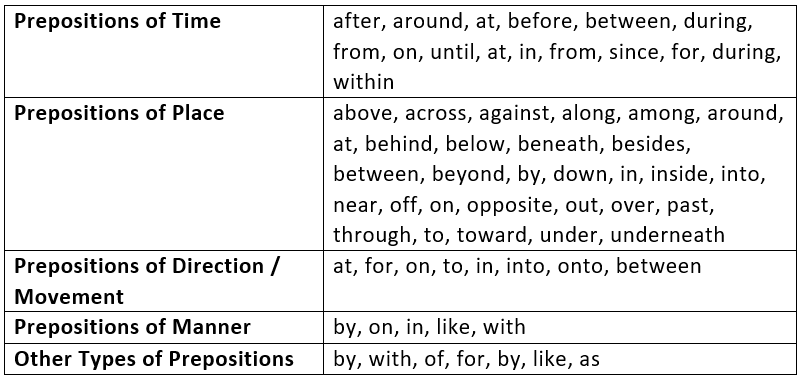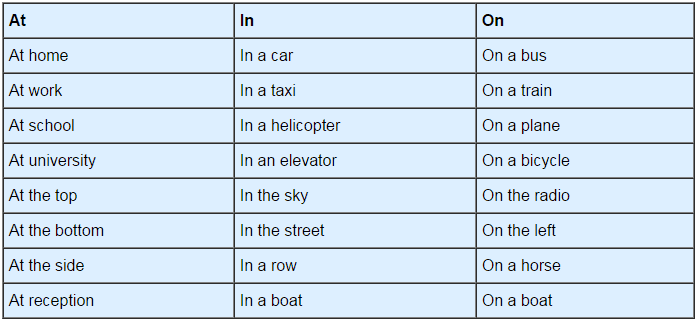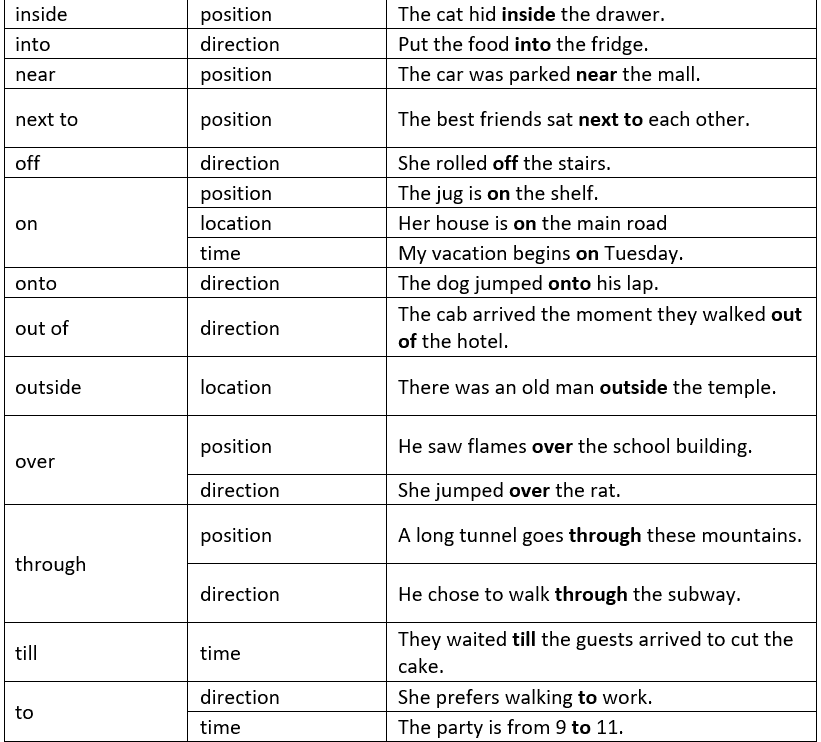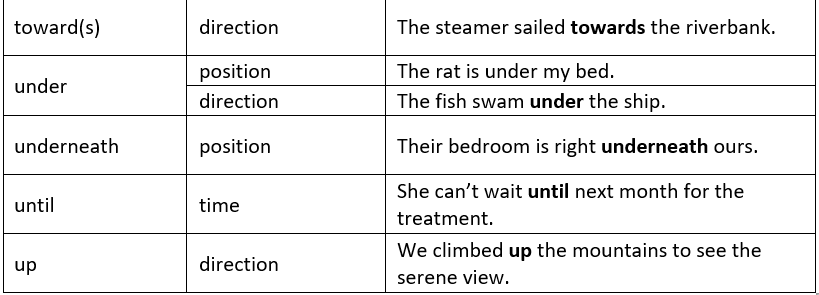Rules & Examples: Prepositions | Verbal Ability (VA) & Reading Comprehension (RC) - CAT PDF Download
| Table of contents |

|
| What is a Preposition? |

|
| Types of Prepositions |

|
| Rules of Prepositions |

|
| Use and Examples of Some Important Prepositions |

|

What is a Preposition?
- A preposition is part of speech in English grammar that is a word or set of words that indicate the location or some other relationship between a noun or pronoun and also other parts of a sentence.
- A preposition shows the relationship between a word in the sentence and the word that is the object of the preposition. Prepositions are known as “the biggest little words” in English because of their important functions.
Types of Prepositions
There are some prepositions that are common in every type of preposition as they function in a versatile way.
Table: Different Types of Prepositions
Rules of Prepositions
➢ Rule 1: Preposition must have an object.
A preposition is not a preposition unless it goes with a related noun or a pronoun that is the object of the preposition. A preposition is always with an object – without an object, it is an adverb that never has an object.
Examples:
- He is in the kitchen. (preposition ‘in’ has object the kitchen)
- You may come in. (adverb ‘in’ has no object; it qualifies come)
- There was a car before me. (preposition ‘before’ has object ‘me’)
- Ram has never seen it before. (adverb ‘before’ has no object; it qualifies seen)
- We will catch up after the gym. (preposition ‘after’ has object ‘gym’)
- They called soon after. (adverb ‘after’ has no object; it qualifies ‘called’)
➢ Rule 2: Must be placed before – As the name says ‘Pre-Position’ – it comes before something. Generally, but not always, a preposition goes before a noun or a pronoun. Example:
- I put the things in the box. (‘in’ is placed before the noun ‘’box’)
 View Answer
View AnswerNote: You do not end a sentence with a preposition is one of the undying myths of English Grammar because even when a preposition is not placed before its object, it is closely related to its object.
Example:
Whom did you talk to? (Preposition ‘to’ related to the pronoun ‘Whom’)
➢ Rule 3: The Pronoun following the Preposition should be an object form.
The noun or pronoun following a preposition forms a prepositional object. If a pronoun is following a preposition, it should be in the objective form ( me, her, them) and not the subjective form like (I, she, they, etc.).
Examples:
- The gift was from them. (preposition ‘from’ followed by the objective pronoun ‘them’)
- The secret is between him and her. (preposition ‘between’ followed by the objective pronoun ‘him’)
➢ Rule 4(A): Avoid ‘like’ when a verb is involved.
The preposition ‘like’ that means “similar to” should be followed by a noun, pronoun, noun phrase as an object of the preposition. A subject or a verb should not follow the preposition ‘like’.
Examples:
- Correct – She looks like her mother. (noun ‘mother’ is the object of the preposition ‘like’)
- Incorrect – She looks like her mother does. (avoid ‘like’ with noun + verb)
➢ Rule 4(B): When there is a comparison between a subject or verb, instead of like, use as, as if, as though, or ‘the way’.
Examples:
- Incorrect: She looks like her mother does.
- Correct: She looks the way her mother does.
- Incorrect: Do like he asks.
- Correct: Do as he asks.
- Incorrect: She looks like she is angry.
- Correct: She looks as if she is angry.
➢ Rule 4(C): Unless there is a verb involved, do not use ‘as’. ‘As’ means “in the same manner” so avoid using the preposition ‘as’ if the verb is not involved.
Examples:
- Incorrect: I, as most people, try to use good words in English.
- Correct: I, as most people do, try to use good words in English. Or I, like most people, try to use good words in English.
➢ Rule 5: Do not confuse the preposition ‘to’ with infinitive ‘to’.
‘To’ is an infinitive participle (to sing, to dance, etc.) as well as a preposition too like (to me, to Moscow, etc.).
Examples:
- ‘To’ as a Preposition:
I am used to swimming.
I look forward to seeing you. (not ‘see you’)- ‘To’ as an Infinitive Participle:
I used to live in Australia.
They love to dance.
➢ Rule 6: Some words that look like verbs follow the preposition ‘to’. A Verb cannot be an object of a preposition. This rule of preposition may seem confusing, so let us understand with examples.
Examples:
- I like to swim.
- These goggles are for swimming.
- In these examples, “swim” and “swimming” are not acting as verbs.
- In the first example, to swim is part of the infinitive that occurs when a verb is used as a noun, adverb or adjective. Here, to swim is a thing that the person likes doing, not an action that is being performed.
- In the second example, swimming is a gerund which is a noun though it is formed out of a verb. Here, swimming is a thing to which goggles are related. No one in this sentence is performing the act of swimming.
➢ Rule 7: Do not confuse the preposition ‘In’ and ‘Into’.
This rule of preposition says, use “into” to express motion toward something and reserve the preposition “in” when you want to indicate a location.
Examples:
- I swam in the pool. (Indicating location)
- Look in the almirah. (Indicating location)
- The cat jumped into the well. (Expressing motion)
- He drove into the city. (Expressing motion)
Use and Examples of Some Important Prepositions
1. At/In/On
In reference to ‘Time’
- At is used for a precise time.
- In is used for months, years, centuries and long periods.
- On is used for days and dates.
In reference to ‘Place’
- At is used for a point.
- In is used for an enclosed space.
- On is used for a surface.
(i) At shows stationary position or existing state while In shows movement.
Examples:
- She is at home.
- The train is in motion.
(ii) At for small place, town etc. while In for big place, town, city, country etc.
Examples:
- He lives at Alwar in Rajasthan.
- A temple is situated at Madurai in Chennai.
(iii) At is used for a Point of time, and In is used for a Period of time.
Examples:
- The train will arrive at six in the morning.
- He will meet you in the morning.
(iv) In/Into In shows the existing state of things, while Into shows movement.
Examples:
- He jumped into the river.
- There are three students in the class.
Some other common uses of At/On/In

2. To/Into
- In the direction of: Turn to the right.
- Destination: I am going to Jaipur.
- Until From: Monday to Friday; five minutes to ten
- Compared with: They prefer hockey to soccer.
- With indirect object: Please give it to me.
- As part of the infinitive: I like to ski; he wants to help.
- In order to: We went to the store to buy soap.
- To the inside of: We stepped into the room.
- Change of condition: The boy changed into a man.
3. On/Onto
(i) On can be used for both existing position and movement.
Examples:
- He was sitting on his bag.
- Snow fell on the hills.
(ii) On can also be used as an adverb
Examples:
- Go on.
- Come on.
(iii) Onto is used when there is a movement involving a change of level.
Examples:
- People climbed onto their roofs.
- He lifted her onto the table.
4. With/By
With is used for instruments, and By is used for agents.
Examples:
- The snake was killed by him with a stick.
- The letter was written by Suresh with a pencil.
5. Since/For/From
(i) Since is often used with Present Perfect or Past Perfect Tense
Examples:
- It has been raining since two O’Clock.
- He had been ill since Monday.
(ii) Since can also be used as an adverb
Examples:
- He left school in 1983. I haven’t seen him since.
- It is two years since I last saw Tom.
6. Beside/Besides
Beside and Besides have altogether different meanings.
Don’t confuse beside with besides.
(i) beside = at the side of
Example: He was sitting beside Sarla.
(ii) besides = in addition to / as well as
Example: He has a car besides a motorcycle.
7. Between/Among
(i) Between is normally used for ‘two things or persons, but it can also be used more when we have a definite number in mind and there is a close relationship/ association within them.
Examples: He distributed his property between his two daughters.
(ii) Among is usually used for more than two persons or things when we have no definite number in mind.
Example: He was happy to be among friends again.
8. Among/Amongst
Both have the same meaning. Either of them can be used if followed by 'the'. If followed by a word, beginning with a vowel 'amongst' be used.
Examples:
- He distributed the toffees among/amongst the poor.
- He distributed the toffees amongst us.
9. More Prepositions




|
129 videos|360 docs|95 tests
|
FAQs on Rules & Examples: Prepositions - Verbal Ability (VA) & Reading Comprehension (RC) - CAT
| 1. What is a preposition? |  |
| 2. What are the types of prepositions? |  |
| 3. What are the rules of prepositions? |  |
| 4. How are prepositions used in sentences? |  |
| 5. Can you provide some examples of important prepositions? |  |
|
129 videos|360 docs|95 tests
|

|
Explore Courses for CAT exam
|

|


















